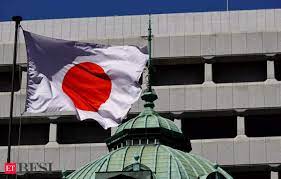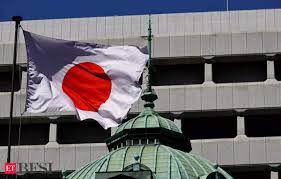
The Bank of Japan (BOJ) marked a historic departure from its focus on reflating growth with decades of huge monetary stimulus on Tuesday, ending eight years of negative interest rates and other remains of its unconventional policy.
Although it was Japan's first interest rate increase in 17 years, analysts note that the measure essentially maintains rates unchanged as the country's central bank is forced to take its time raising borrowing costs due to a shaky economic recovery.
With this change, Japan becomes the final central bank to remove negative interest rates, bringing an end to a period in which governments attempted to boost economy via unconventional monetary policies and cheap money on a global scale.
"We reverted to a normal monetary policy targeting short-term interest rates, as with other central banks," BOJ Governor Kazuo Ueda said at a press conference after the decision.
"If trend inflation heightens a bit more, that may lead to an increase in short-term rates," Ueda said, without elaborating on the likely pace and timing of further rate hikes.
The BOJ abandoned a programme that former Governor Haruhiko Kuroda had implemented since 2016 and which levied a 0.1% fee on certain excess reserves that financial institutions kept on deposit with the central bank. This move was widely anticipated.
The BOJ chose to guide the overnight call rate in a band of 0-0.1% and set it as its new policy rate. It did this in part by giving deposits at the central bank an interest rate of 0.1%.
In a historic decision, the BOJ concludes its huge stimulus programme, which has lasted for ten years, by eliminating negative interest rates. In part, by providing 0.1% interest on deposits held at the central bank, the bank decided to steer it within the range of 0-0.1%.
In a historic decision, the BOJ concludes its huge stimulus programme, which has lasted for ten years, by eliminating negative interest rates. In part, by providing 0.1% interest on deposits held at the central bank, the bank decided to steer it within the range of 0-0.1%.
"The BOJ today took its first, tentative step towards policy normalisation," said Frederic Neumann, chief Asia economist at HSBC in Hong Kong.
"The elimination of negative interest rates in particular signals the BOJ's confidence that Japan has emerged from the grip of deflation."
The central bank also stopped buying risky assets and yield curve control (YCC), a programme that had been in place since 2016 and capped long-term interest rates at zero.
However, the BOJ emphasised that it is focused on averting any detrimental surge in borrowing costs by stating that it will continue purchasing "broadly the same amount" of government bonds as previously and increase purchases in the event if yields rise quickly.
In another indication that rate increases in the future will be gradual, the BOJ stated that it anticipates "accommodative financial conditions to be maintained for the time being."
After the judgement, Japanese shares increased. As investors interpreted the BOJ's dovish stance as an indication that the interest rate gap between Japan and the US would probably not widen considerably, the value of the yen dropped below $150 per dollar.
Numerous participants in the market had predicted that negative interest rates will cease in either March or April due to inflation exceeding the BOJ's 2% target for more than a year.
The highest pay increases in 33 years were obtained during unions' annual wage negotiations with large corporations, which raised expectations for a turnaround this week.
With the conclusion of the Kuroda era stimulus, markets, analysts, and the general public are now more focused on the timing of the BOJ's next rate hike.
Already on Tuesday, commercial banks flagged plans to raise some of their deposit rates for the first time since 2007. Before the year is over, Nomura and BNP Paribas predict that the BOJ will raise rates once more.
"Essentially we're a normal country," said Bart Wakabayashi, State Street Tokyo Branch Manager.
"How does this impact households locally and their spending power? I think that's going to be the next big discussion and with an eye to that I don't think the BOJ can do anything beyond what they've announced."
The BOJ launched a massive asset-buying plan in 2013 under Kuroda with the initial goal of driving inflation up to a target of 2% in about two years.
In 2016, the central bank changed its stimulus programme to one that was more sustainable due to poor inflation, which prompted the introduction of negative rates and YCC.
However, the BOJ changed YCC last year to loosen its hold on long-term rates as the significant declines in the value of the yen increased the cost of imports and increased public criticism of the drawbacks of Japan's extremely low interest rates.
There are still risks. The cost of financing Japan's enormous public debt, which is twice the size of its GDP and the biggest among developed countries, would rise in response to an increase in bond yields.The global financial markets may be shocked if cheap funds disappear because Japanese investors, who accumulated assets abroad in pursuit of income, may decide to repatriate their funds.
The BOJ downgraded its assessment of the economy and issued a warning about weak consumption even as it reduced stimulus.
According to Ueda, inflation expectations are still not fixed at 2%, so the BOJ may hike interest rates more slowly than other central banks have in recent years.
"If our price forecast clearly overshoots or, even if our median forecast is unchanged, we see a clear increase in upside risk to the price outlook, that will lead to a policy change," Ueda said on the likely threshold for further rate increases.
(Source:www.japantimes.co.jp)
Although it was Japan's first interest rate increase in 17 years, analysts note that the measure essentially maintains rates unchanged as the country's central bank is forced to take its time raising borrowing costs due to a shaky economic recovery.
With this change, Japan becomes the final central bank to remove negative interest rates, bringing an end to a period in which governments attempted to boost economy via unconventional monetary policies and cheap money on a global scale.
"We reverted to a normal monetary policy targeting short-term interest rates, as with other central banks," BOJ Governor Kazuo Ueda said at a press conference after the decision.
"If trend inflation heightens a bit more, that may lead to an increase in short-term rates," Ueda said, without elaborating on the likely pace and timing of further rate hikes.
The BOJ abandoned a programme that former Governor Haruhiko Kuroda had implemented since 2016 and which levied a 0.1% fee on certain excess reserves that financial institutions kept on deposit with the central bank. This move was widely anticipated.
The BOJ chose to guide the overnight call rate in a band of 0-0.1% and set it as its new policy rate. It did this in part by giving deposits at the central bank an interest rate of 0.1%.
In a historic decision, the BOJ concludes its huge stimulus programme, which has lasted for ten years, by eliminating negative interest rates. In part, by providing 0.1% interest on deposits held at the central bank, the bank decided to steer it within the range of 0-0.1%.
In a historic decision, the BOJ concludes its huge stimulus programme, which has lasted for ten years, by eliminating negative interest rates. In part, by providing 0.1% interest on deposits held at the central bank, the bank decided to steer it within the range of 0-0.1%.
"The BOJ today took its first, tentative step towards policy normalisation," said Frederic Neumann, chief Asia economist at HSBC in Hong Kong.
"The elimination of negative interest rates in particular signals the BOJ's confidence that Japan has emerged from the grip of deflation."
The central bank also stopped buying risky assets and yield curve control (YCC), a programme that had been in place since 2016 and capped long-term interest rates at zero.
However, the BOJ emphasised that it is focused on averting any detrimental surge in borrowing costs by stating that it will continue purchasing "broadly the same amount" of government bonds as previously and increase purchases in the event if yields rise quickly.
In another indication that rate increases in the future will be gradual, the BOJ stated that it anticipates "accommodative financial conditions to be maintained for the time being."
After the judgement, Japanese shares increased. As investors interpreted the BOJ's dovish stance as an indication that the interest rate gap between Japan and the US would probably not widen considerably, the value of the yen dropped below $150 per dollar.
Numerous participants in the market had predicted that negative interest rates will cease in either March or April due to inflation exceeding the BOJ's 2% target for more than a year.
The highest pay increases in 33 years were obtained during unions' annual wage negotiations with large corporations, which raised expectations for a turnaround this week.
With the conclusion of the Kuroda era stimulus, markets, analysts, and the general public are now more focused on the timing of the BOJ's next rate hike.
Already on Tuesday, commercial banks flagged plans to raise some of their deposit rates for the first time since 2007. Before the year is over, Nomura and BNP Paribas predict that the BOJ will raise rates once more.
"Essentially we're a normal country," said Bart Wakabayashi, State Street Tokyo Branch Manager.
"How does this impact households locally and their spending power? I think that's going to be the next big discussion and with an eye to that I don't think the BOJ can do anything beyond what they've announced."
The BOJ launched a massive asset-buying plan in 2013 under Kuroda with the initial goal of driving inflation up to a target of 2% in about two years.
In 2016, the central bank changed its stimulus programme to one that was more sustainable due to poor inflation, which prompted the introduction of negative rates and YCC.
However, the BOJ changed YCC last year to loosen its hold on long-term rates as the significant declines in the value of the yen increased the cost of imports and increased public criticism of the drawbacks of Japan's extremely low interest rates.
There are still risks. The cost of financing Japan's enormous public debt, which is twice the size of its GDP and the biggest among developed countries, would rise in response to an increase in bond yields.The global financial markets may be shocked if cheap funds disappear because Japanese investors, who accumulated assets abroad in pursuit of income, may decide to repatriate their funds.
The BOJ downgraded its assessment of the economy and issued a warning about weak consumption even as it reduced stimulus.
According to Ueda, inflation expectations are still not fixed at 2%, so the BOJ may hike interest rates more slowly than other central banks have in recent years.
"If our price forecast clearly overshoots or, even if our median forecast is unchanged, we see a clear increase in upside risk to the price outlook, that will lead to a policy change," Ueda said on the likely threshold for further rate increases.
(Source:www.japantimes.co.jp)





